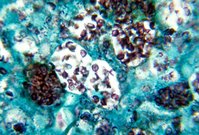Histoplasmosis
Histoplasmosis is a disease caused by the fungus Histoplasma capsulatum. Its symptoms vary greatly, but the disease primarily affects the lungs. Occasionally, other organs are affected—this form of the disease is called disseminated histoplasmosis, and it can be fatal if untreated. more...
H. capsulatum is found throughout the world and is endemic in certain areas of the United States. The fungus has been found in poultry house litter, caves, areas harboring bats, and in bird roosts(especially Starlings).
Incidence
Positive histoplasmin skin tests occur in as many as 80% of the people living in areas where H. capsulatum is common, such as the eastern and central United States. Infants, young children, and older persons, in particular those with chronic lung disease, are at increased risk for severe disease. Disseminated disease is more frequently seen in people with cancer or AIDS.
Causes
H. capsulatum grows in soil and material contaminated with bat or bird droppings. Spores become airborne when contaminated soil is disturbed. Breathing the spores causes infection. The disease is not transmitted from an infected person to someone else.
Transmission
H. capsulatum grows in soil and material contaminated with bat or bird droppings. Spores become airborne when contaminated soil is disturbed. Breathing the spores causes infection. The disease is not transmitted from an infected person to someone else.
Symptoms
If symptoms occur, they will start within 3 to 17 days after exposure; the average is 10 days. Most infected persons have no apparent ill effects. The acute respiratory disease is characterized by respiratory symptoms, a general ill feeling, fever, chest pains, and a dry or nonproductive cough. Distinct patterns may be seen on a chest x-ray. Chronic lung disease resembles tuberculosis and can worsen over months or years. The disseminated form is fatal unless treated.
Treatment
Antifungal medications are used to treat severe cases of acute histoplasmosis and all cases of chronic and disseminated disease. Mild disease usually resolves without treatment. Past infection results in partial protection against ill effects if reinfected.
Prevention
It is not practical to test or decontaminate most sites that may be contaminated with H. capsulatum, but the following precautions can be taken to reduce a person's risk of exposure:
- Avoid areas that may harbor the fungus, e.g., accumulations of bird or bat droppings.
- Before starting a job or activity having a risk for exposure to H. capsulatum, consult the NIOSH/NCID Document Histoplasmosis: Protecting Workers at Risk. This document contains information on work practices and personal protective equipment that will reduce the risk of infection.
Note: The original version of this article is adapted from the U.S. CDC public domain document at
Read more at Wikipedia.org



